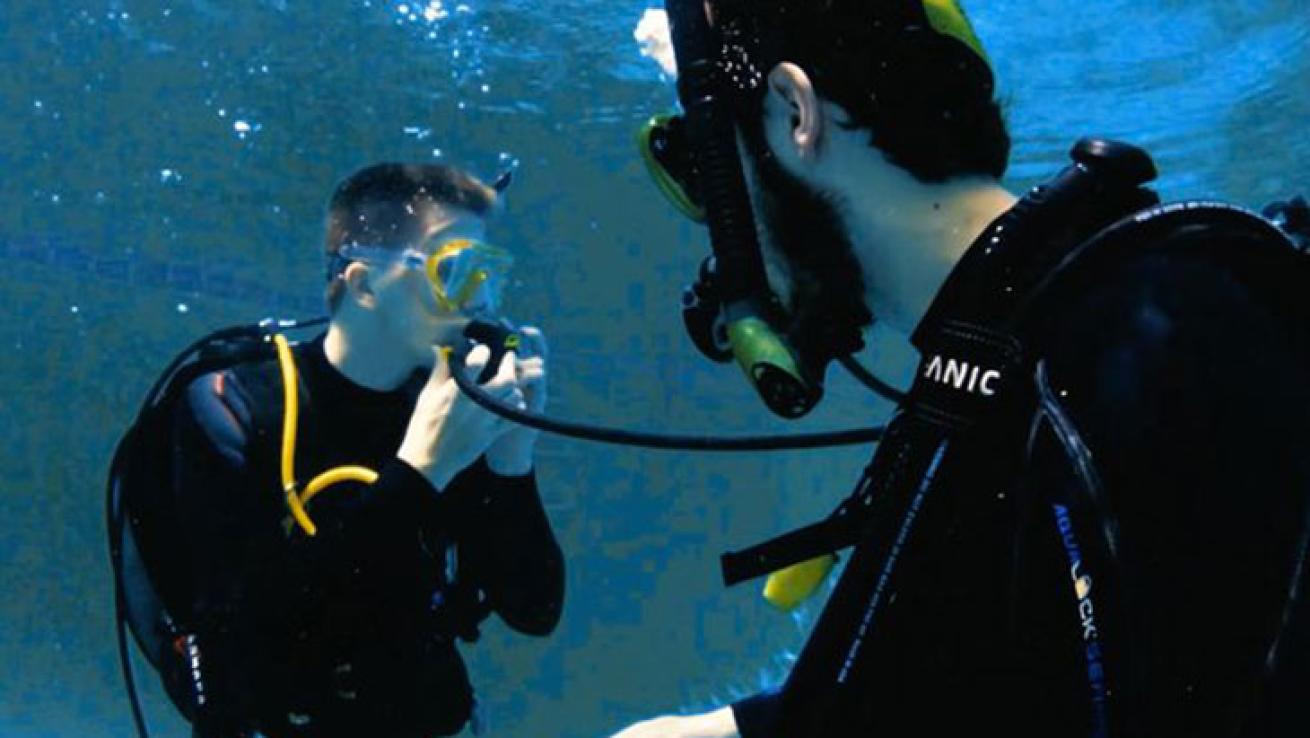Basic Scuba Diving Skills

Chris Balogh and Stevan LlewellynA scuba diving certification course will introduce you to all of the basic skills needed for a fun and safe dive.
The words lesson, course or even learning may bring back bad memories for those who dreaded going to school as a kid. But while a scuba diving certification course is certainly informative, it’s also plenty of fun. We took the time to demonstrate a few of the basic skills you may learn in your course. Keep in mind: we are not instructors! This is meant to be an example of what you will learn, not a study tool.
Common Hand Signals
Communication is key when it comes to scuba diving. Here are the most common scuba diving hand signals — from out of air to danger to shark — that will help you get the message across to you buddy.
Free-Flowing Regulator
What if my regulator malfunctions?
Most new divers are worried about their regulator malfunctioning and cutting off their air supply. To prevent this, most regulators are designed with a fail-safe. Any problems with the reg will cause it to go into a freeflow, during which the reg constantly emits air, rather than cutting off the gas supply. While the resulting stream of bubbles is quite powerful, by sipping the escaping air like you would a water fountain, you can breathe off of a malfunctioning reg and return to the surface.
Gear Assembly
First things first, you can’t dive if your scuba gear isn’t put together.
When you start assembling your gear, all of the hoses and connectors can seem very intimidating. With an instructor’s help and a couple of dives under your belt you’ll soon get the hang of it. Not only will you know how to set up your gear, but you’ll find how to get the perfect fit for your ease of use and comfort.
Gear Removal and Replacement
Taking your gear off underwater is a useful skill.
Typically scuba divers don’t have to take off their gear while underwater. This skill is normally only done during training to help new divers get comfortable with their equipment and doing complex skills underwater. However, sometimes you do need to remove your gear (perhaps it has gotten tangled in kelp) and it always helps to know you can remove and replace it when needed.
Giant-Stride Entry
AKA The fastest way from the boat to the water.
The giant stride is a tried and true method for scuba divers entering from a large boat. This entry method is as straight forward as it gets — literally. After getting into your dive gear you simply take a large step, straight off the boat while holding your mask and regulator in place. After a moment of hang time you’re in the water and ready to explore.
Kick Styles
There’s more than one way to get around underwater.
Two of the most popular kicking styles for scuba divers are the flutter kick and frog kick. The flutter kick is used to quickly cover ground or swim against strong currents. The frog kick is ideal for tight spaces or when you want to refrain from kicking up silt or sand.
Mask Clear
Sometimes masks will fog up or get filled with water (whether due to a leak or being removed and replaced) and divers need to clear them. You can easily remove water from your mask by looking up and exhaling through your nose while holding the top of the mask against your forehead are lifting the skirt of the mark up slightly.
Regulator Purge
But what happens if I get water in the regulator?
It’s only natural to worry about getting water in your regulator, but the solution is very simple: your reg is designed to push water out when you exhale. All you need to do is breath out. If for some reason that doesn’t work, or you don’t have enough air in your lungs to push out all the water, your regulator also has a purge button that will use air from your tank to blast the water out.
Regulator Recovery
Uh oh, I dropped my regulator while underwater. Not to worry, it’s not going anywhere. Just because your reg isn’t in your mouth doesn’t mean it isn’t attached. You can easily find it by shifting your body and letting it dangle away from you, or reach up to where it connects to the tank and follow the hose to find the mouthpiece. The most important thing to remember whenever your regulator is out of your mouth is to exhale continuously and never hold your breath.
Sharing Alternate Air Source
Buddy breathing isn’t as complicated as it used to be.
These days if you happen to run out of air, which you shouldn’t as long as you pay attention to your pressure gauge, you can count on your buddy to have an alternate air source. No longer do divers need to rely on passing a reg back and forth. With an alternate air source, or octo, both divers can breathe off a single tank using individual regulators.
Weight Removal and Replacement
Sometimes you just need to get the lead out.
This is a skill best reserved for emergencies, like if you need to get up to the surface because you’ve completely run out of air or you find yourself sinking uncontrollably. Removing weight changes your buoyancy and makes you lighter in the water. This is done by either removing integrated weight pockets from your BC or weight belt.










